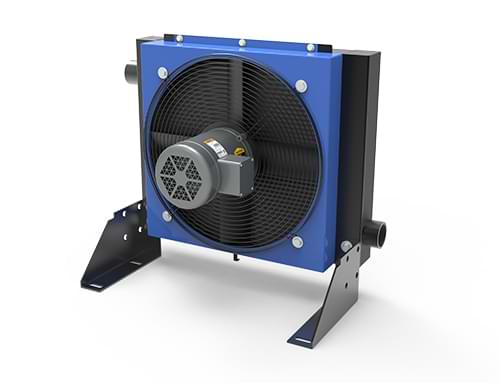Reciprocating/Piston Compressor Aftercoolers
Aftercoolers are critical for reciprocating or piston compressors, cooling compressed air to remove heat and moisture. This ensures system reliability, prevents corrosion, and delivers high-quality air for industries like automotive, manufacturing, and construction.
- Air-Cooled Aftercoolers: Air-cooled aftercoolers cool reciprocating compressor air using ambient air, ideal for portable or water-scarce setups.
- Water-Cooled Aftercoolers: Water-cooled aftercoolers offer high-efficiency cooling, achieving approach temperatures of 10-15°F for stationary piston compressors.
- Moisture Separators: Moisture separators remove condensed water post-cooling, essential for maintaining air quality in piston compressor systems.
- Materials: Constructed with copper tubes, steel shells, and optional CuNi for corrosive environments, ensuring durability and performance.
- High-Temperature Handling: Aftercoolers manage discharge temperatures up to 350°F, common in reciprocating compressors.
- Custom Solutions: Tailored custom aftercoolers for specific reciprocating compressor applications and high-pressure needs.
Water Cooled Aftercoolers
Compressor Cooling
- Fixed or Removable Tube Bundles
- Material Options Available
- Standard and Custom Options

Air Cooled Aftercoolers
Compressor Cooling
- Use Ambient Air to Cool
- Variety of Motor Options
- Standard Pressures of Up To 250 psi

Aftercoolers for Reciprocating/Piston Compressors
Aftercoolers are vital for reciprocating or piston compressors, cooling compressed air from temperatures as high as 350°F and removing up to 75% of moisture content. They ensure equipment longevity and deliver dry, high-quality air for applications in construction, manufacturing, and automotive industries.
Designed for durability with materials like copper tubes and steel shells, these aftercoolers minimize pressure drops and support high-pressure operations up to 250 PSI. Available in air-cooled and water-cooled configurations, they meet the diverse needs of reciprocating compressor systems.
Understanding the Need for Aftercoolers in Reciprocating Compressors
Reciprocating compressors use pistons to compress air, producing high discharge temperatures (300-350°F) and moisture. Without aftercoolers, this hot, moist air can corrode pipes, damage tools, and reduce system efficiency. Aftercoolers cool the air to 80-100°F, condensing moisture for removal, ensuring clean air for downstream processes.
Effects of High-Temperature Compressed Air
High-temperature air from reciprocating compressors can cause equipment wear, increase maintenance costs, and degrade air quality. For instance, a 200 CFM piston compressor at 100 PSIG can introduce 45 gallons of water daily without cooling, impacting tools and processes. Aftercoolers prevent these issues by cooling air and removing moisture.
Controlling Temperature in Reciprocating Compressor Systems
Temperature control is critical for reciprocating compressor performance. Aftercoolers use ambient air or cooling water to transfer heat from compressed air. A large temperature difference between the air and cooling medium ensures efficient heat transfer, with water-cooled aftercoolers achieving approach temperatures of 10-15°F for optimal cooling.
Regulative Cooling Processes
Regulative cooling for reciprocating compressors involves reducing compressed air temperatures to safe levels and removing moisture. Air is cooled from 300°F to 80°F, then passed through a moisture separator. This process reduces the load on air dryers and can recover heat for other uses, enhancing energy efficiency.
Types of Aftercoolers for Reciprocating/Piston Compressors
Aftercoolers for reciprocating compressors are designed to handle high temperatures and moisture levels. The key types include:
Air-Cooled Aftercoolers
- Common for portable reciprocating compressors, using ambient air to cool air to within 15-20°F of ambient.
- Ideal for construction and small-scale applications with limited water access.
Water-Cooled Aftercoolers
- Preferred for stationary reciprocating compressors with access to cooling water.
- High-efficiency cooling with approach temperatures of 10-15°F, suitable for high-pressure and high-CFM systems.
Integrated Aftercoolers
- Built into some reciprocating compressors for compact cooling solutions.
- May require additional standalone aftercoolers for high-duty-cycle applications.
Custom Aftercoolers
- Tailored for specific reciprocating compressor models, handling extreme temperatures or pressures.
These aftercoolers ensure efficient cooling, moisture removal, and system reliability for reciprocating compressors in various industrial settings.


